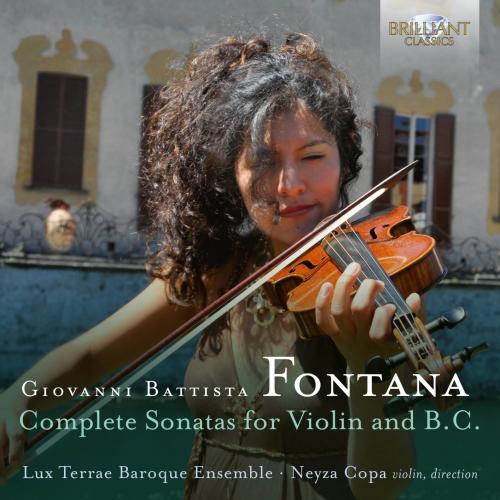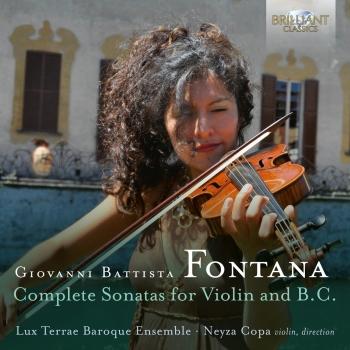
Fontana: Complete Sonatas for Violin and B.C. Lux Terrae Baroque Ensemble & Neyza Copa
Album info
Album-Release:
2023
HRA-Release:
28.04.2023
Label: Brilliant Classics
Genre: Classical
Subgenre: Chamber Music
Artist: Lux Terrae Baroque Ensemble & Neyza Copa
Composer: Giovanni Battista Fontana (1571-1631)
Album including Album cover Booklet (PDF)
- Giovanni Battista Fontana (1589 - 1630): Complete Sonatas for Violin and B.C.:
- 1 Fontana: Sonata prima, No. 1, IGF 2 04:48
- 2 Fontana: Sonata seconda, No. 2, IGF 4 07:12
- 3 Fontana: Sonata terza, No. 3, IGF 3 05:16
- 4 Fontana: Sonata quarta, No. 4 05:49
- 5 Fontana: Sonata quinta, No. 5 06:04
- 6 Fontana: Sonata sesta, No. 6 06:51
- 7 Fontana: Sonata decima, No. 10 07:12
- 8 Fontana: Sonata nona, No. 9 06:29
- 9 Fontana: Sonata duodecima, No. 12 06:21
- 10 Fontana: Sonata ottava, No. 8 06:55
- 11 Fontana: Sonata terzadecima, No. 13 06:02
- 12 Fontana: Sonata quartadecima, No. 14 07:26
- 13 Fontana: Sonata undecimal, No. 11 08:25
- 14 Fontana: Sonata sestadecima, No. 16 05:37
- 15 Fontana: Sonata decimasettima, No. 17 06:08
- 16 Fontana: Sonata quintadecima, No. 15 04:52
- 17 Fontana: Sonata settima, No. 7 07:14
- 18 Fontana: Sonata decimaottava, No. 18 07:21
Info for Fontana: Complete Sonatas for Violin and B.C.
The only available complete recording of a hugely influential set of Baroque trio sonatas by a northern-Italian pioneer of the genre.
Unrivalled in its breadth, renowned for reviving countless names of the past in authoritative new recordings, the Baroque-music catalogue of Brilliant Classics welcomes a significant new name to its long list of forgotten composers: Giovanni Battista Fontana (1589–1630). Born in Brescia, dying in nearby Padova, Fontana is known for a single major publication, a collection of 18 Sonate a 1, 2, 3 per il violino o cornetto, fagotto, chitarone, violoncino o simile altro instromento, published posthumously in Venice in 1641.
The Italian early-music Lux Terrae ensemble presents a new recording of the complete set, demonstrating its foundational significance within the rich history of the Italian trio sonata as a genre. As in the chiaroscuro technique in painting, that defines images through the play of of light and shade, Fontana uses a musical chiaroscuro that lends theatricality and dynamism to these sonatas through a dialectic of contrasts and resolutions between contrasting idioms.
All 18 sonatas follow a single-movement form, divded into contrasting sections. Their melodic material breathes the cantabile air of the 17th-century canzona or the dance and sometimes recurs, invariably elaborated, to form a simple arch design.
Sonatas Nos. 2 and 6, on the other hand, comprise sections that grow out of recitative-like monody interspersed with freer instrumental flourishes, but subdivisions in dance-like triple metre are rarely absent for long.
Lux Terrae is led from the violin by the Italian-trained Bolivian violinist Neyza Copa, who also introduces these Baroque rarities in a booklet essay. For her, Fontana’s sonatas shine as ‘a real jewel of the early Baroque, both in terms of the stylistic evolution of instrumental composition, and the development of an idiomatic language for the violin… Fontana is probably the most important composer of early Baroque violin music.’
Giovanni Battista Fontana was an early Baroque Italian composer and violinist.
He was born in Brescia, and was active in his home town, Rome, Venice, and Padua. He died in Padua during the plague in the years of 1629–1631.
Fontana’s only existing works are the collection of 18 sonatas, published in Venice in 1641. The sonatas are for violin and a rich basso continuo, existing of viola da gamba, cello, theorbo, dulcian, flute, harpsichord or organ. Fontana’s style tends to the unusual, to the surprise, using passages rich in fantasy, unexpected changes of “affetti” and sudden explosions of virtuosity after sections of meditative character. According to Willi Apel, “Fontana is probably the most important composer of early Baroque violin music, having mastered both the virtuoso and cantabile style of the violin”.
Bolivian violinist Neyza Copa specialized in Baroque violin, in particular “lo stile italiano”, with the study of historical treatises, basso continuo, improvisation, and diminution technique. Neyza is artistic director of the Lux Terrae Baroque Ensemble, with which she has an intense concert activity dedicated particularly to Italian baroque music and “Mission Baroque”.
Lux Terrae Baroque Ensemble
Neyza Copa, violin & direction
No biography found.
Booklet for Fontana: Complete Sonatas for Violin and B.C.











